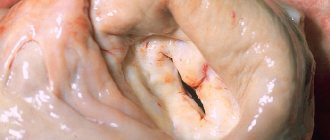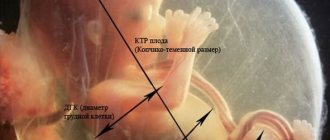Often, bearing a child is accompanied by various pathological conditions; one of the common problems is gestosis (or preeclampsia). It can occur both during pregnancy and directly during or immediately after childbirth. This pathology is accompanied by disruption of the functioning of vital organs. A woman often experiences vascular spasm (generalized) in all tissues, affecting the nervous system, heart, kidneys, and liver. This condition also has a negative impact on the fetus.
Appointment with an obstetrician-gynecologist, MD. 2,600 rub.
Appointment with an obstetrician-gynecologist of higher education. cat. from 2,500 rub.
Admission of Doctor of Medical Sciences hemostasiologist RUB 2,600.
All prices Make an appointment
According to statistics, gestosis occurs in almost 15% of cases. Without treatment, the pathology leads to irreversible changes in the body, and in severe cases can cause the death of a woman and child. But fortunately, thanks to modern diagnostic methods, such a condition can be predicted and eliminated in the early stages. Let's figure out how treatment occurs and what symptoms should alert a pregnant woman.
Classification of pathology
This disease is often also called late toxicosis, but this name is incorrect. Unlike toxicosis, gestosis requires treatment, since it is not a normal variant. Depending on the severity of symptoms, there are 4 stages of the disease:
- Dropsy. It often goes unnoticed, as it is characterized only by swelling.
- Nephropathy. In addition to swelling, a pregnant woman may find protein in her urine. At this stage, kidney damage occurs; if left untreated, complications may arise.
- Preeclampsia. Characterized by increased blood pressure and accompanying symptoms: headache, nausea, etc. Possible disruption of cerebral blood supply.
- Eclampsia. This stage is the most dangerous. A pregnant woman often experiences convulsions, placental abruption, heart attack and other serious consequences can occur.
Treatment
If you suspect gestosis and the first symptoms appear, you should contact a gynecologist as soon as possible. Initially, the complication can be treated at home. But, of course, it is better to go to a hospital in order to be under constant control and if the condition worsens, doctors will be able to provide assistance in a timely manner.
The doctor will prescribe tests and examination to identify the provoking factor. After the conclusion, the correct treatment will be prescribed. In severe cases, the woman in labor will be urgently hospitalized and may even undergo a caesarean section.
With this diagnosis, a woman must follow a certain diet:
- spicy, smoked and pickled foods are not allowed;
- you can drink no more than a liter of liquid per day;
- food rich in proteins and vitamins.
Medications prescribed include sedatives and tablets to normalize blood pressure, most often Dopegit.
Complications after gestosis
The last stage of pathology can lead to a number of serious consequences:
- Intracerebral hemorrhage.
- Hemorrhagic shock.
- Premature placental abruption.
- Retinal detachment and vision loss.
- Acute renal failure.
- Coma after convulsions.
Fetal complications:
- Developmental delay syndrome.
- Intrauterine oxygen deficiency (hypoxia).
- Antenatal death.
Such conditions can be avoided by undergoing regular examination and observation by an experienced gynecologist.
Causes of pathology
There are several theories that explain the development of preeclampsia and eclampsia in pregnant women. Let's look at the main ones:
- Cortico-visceral theory. According to her, gestosis is a neurotic condition that occurs due to a disruption of the physiological connection between the cortex and subcortex of the brain.
- Immunological. Pathology occurs due to an incorrect reaction of the pregnant woman’s immune system to fetal antigens.
- Genetic. There is speculation about a possible “eclampsia gene” that is inherited. According to the theory, gestosis is 8 times more common in women whose mothers suffered from a similar disease.
- Endocrine. According to this theory, pathology develops due to improper functioning of the body's endocrine system.
- Placental. The disease is caused by impaired development of the placenta, as a result of which blood flow is disrupted and hypoxia occurs.
It is worth noting that a unified theory explaining the development of gestosis has not yet been identified. According to scientists, a combination of several factors leads to pathology.
Women who have one of the following factors are at increased risk:
- Age under 18 and over 35 years old.
- Multiple pregnancy.
- Postponed early gestosis.
- Extragenital diseases.
- Presence of obesity.
Symptoms of the disease
The most obvious signs of pathology are the following:
- Constant headaches, poor health.
- "Floaters" before the eyes.
- Nausea and vomiting, fever.
- Dry cough, hoarseness of voice.
- Chills, fever.
- Swelling of the legs, arms and face.
- Arterial hypertension.
If such symptoms appear in the 3rd trimester, a woman is prescribed a number of additional examinations to diagnose gestosis. Most often, the patient additionally exhibits disturbances in uteroplacental blood flow, the presence of protein in the urine, a decrease in the number of platelets and a decrease in the concentration of anticoagulants.
Treatment and prevention
To diagnose the early stages of gestosis, the McClure-Aldrich test is used, which allows you to identify hidden edema. A blood test is also performed to determine the platelet count, as well as the presence of protein. A Doppler examination of the fetus and an ultrasound of the kidneys are performed. In our clinic, Professor S.M. Voevodin and Professor A.D. Lipman conduct an expert study - ECG + blood flow in the uterine and fetal vessels (ultrasound-EKIPFS). This study is done using specialized equipment and allows us to identify the risks of gestosis at a preclinical level or assess the dynamics of fetal development, as well as the effectiveness of therapy against the background of gestosis. In addition, a scientific group of clinic doctors has developed an algorithm for managing a patient at risk of preeclampsia and miscarriage, which allows minimizing risks.
Based on the diagnostic results, the patient’s health status is determined. If signs of gestosis are detected, a number of drugs are prescribed, including sedatives and antihypertensives, anticoagulants and antioxidants. Intravenous influences can be carried out aimed at replenishing the volume of circulating blood. The fact is that in most patients with gestosis, the hemostasis system is disrupted. Therefore, consultation or observation with a hemostasiologist is important. If treatment does not bring the desired results, then delivery is necessary - most often a cesarean section is performed.
But it is worth noting that these are extreme measures; with a competent approach from a specialist, it is possible to detect and treat gestosis during pregnancy in the early stages. Therefore, be sure to tell your doctor even if you feel a slight deterioration in your health.
If you have any questions about this pathology, you can ask them to the specialists at our International Hemostasis Clinic in Moscow. Make an appointment using the online form or by phone.
Causes
Unfortunately, it is impossible to completely prevent the development of gestosis. Doctors still cannot identify any underlying cause. This is influenced by a combination of individual factors: chronic diseases, heredity, characteristics of the course of pregnancy.
There is a risk group of women who have a greater chance of developing pathology:
- early age of the expectant mother up to 18 years old or, conversely, late – 30;
- pregnancy using IVF;
- conception through incest;
- chronic diseases (diabetes, asthma and others);
- bearing several fruits;
- have had infectious diseases during pregnancy;
- associated complications during gestation.
Patients included in this group should carefully monitor their well-being and undergo tests in a timely manner in order to identify the pathology at the beginning and take corrective measures.
Gynecologists strongly recommend these same tips be followed by other women, even if they are not at risk. Now most doctors agree that the main reason for the development of complications is a disruption of the internal functioning of blood vessels, which provokes microthrombosis in the organs and placenta.
The placenta is a key character in pregnancy
So, we have come to the most important point in the physiology of pregnancy. From the mother's blood, everything necessary, and first of all water, is obtained by another main character of pregnancy, which is not well known - the child's temporary organ called the placenta.
The placenta begins to form like this. Approximately on the 7th day after conception, after traveling a long way through the fallopian tube, the embryo ends up in the uterus. An embryo is an unborn child in a vesicle, the shell of which is covered with villi. When the vesicle is near the wall of the uterus, it first attaches to it with its villi, and then gets to work: with the villi it rebuilds the vessels of the uterus so that they become dilated, full of blood, and around the villi itself they form a mini-pool of mother’s blood, which is constantly and quickly renewed . In this case, the baby’s blood in the villus and the mother’s blood in the pool do not mix. Much like a germinating seed, its roots absorb water and everything it needs from the soil, but not sand, clay and other large objects. “You provide us with building materials, but we know what and how to build,” both the embryo-child and the seed of the plant seem to be saying.
The seed takes roots from the soil only what it offers it. It cannot cause rain, or turn an underground source towards itself. Not so with the placenta: it is not a simple pump that pumps out what is given. No, she, in the apt expression of Michel Auden, is a “baby’s lawyer,” who, among other things, knows how to intervene in the physiology of the mother’s body and “squeeze” out of it what the baby needs. And if the blood pressure (and it is provided by water) in the placenta and the baby begins to fall, she will do everything to get the necessary fluid.
The placenta grows and develops; its construction also requires nutrients from the mother’s blood, and by 18 weeks its formation is generally completed. That is, by the time the child’s rapid growth begins, there should already be a powerful, functional placenta.
So, let's remember two facts well. First: the amount of water in the mother’s blood determines the amount of water in the child, as well as how well building substances will flow to him. Second: the placenta, as an active organ-advocate of the child, in case of shortage, will manipulate the mother’s body so as to receive enough nutrition and water. Up to conflicts.
Water is a key element of pregnancy
It is known that the human body is approximately 80 percent water. This means that water is the most important component of our body. During a normal pregnancy, even more water is collected, as much as 6–8 liters, 4–6 of which are outside the body tissues, and 2–3 in the tissues. By the end of pregnancy, about 3 liters of water accumulate in the baby, placenta and amniotic fluid. Another three liters are used to increase the mother’s blood volume, to grow and enlarge the uterus and mammary glands. This is such a flood! Note: this is designed so that there is a lot of water. Whether anyone likes it or not.
The volume of the liquid part of the blood begins to increase very early, from 8 weeks of pregnancy. But, for example, the number of red blood cells is only from 18 weeks. It seems that fluid accumulation is a phenomenon of paramount importance, since the body begins to deal with it so early. And it’s true: after all, how liquid and fluid the blood is, so quickly it can deliver nutrients for the growth of the child, uterus, and mammary glands. And blood can fill a whole new vascular system only if there is a lot of it.
However, the child’s vascular system and all the water space around him is not filled with maternal blood or plasma. Then where does the child get fluid from?
Prevention
For prevention, you need to follow basic recommendations, but unfortunately, even this will not guarantee that preeclampsia will not occur. Therefore, timely observation by a gynecologist is one of the keys to a successful pregnancy.
Recommendations:
- absence of stress and neuroses;
- quality sleep, rest;
- proper nutrition;
- acceptable physical activity;
- walks in the open air;
- weight gain control;
- strengthening the immune system.
Being in an interesting position, a woman should carefully monitor her well-being. Preeclampsia can lead to tragic consequences, so at the first signs you need to consult a doctor for help.
Water accumulation and blood loss
Here’s another reason why you should endure the flood that pregnancy brings with it, and not prescribe dehydrating medications and diets: a woman will experience blood loss during childbirth. I'm not even talking about bleeding (although this happens), just normal blood loss, after which you will have to recover.
Now call on common sense to help: which woman will better tolerate blood loss and recover faster: the one who has a lot of blood, or the one who has little? The one that lost thick concentrated blood, or the one that lost diluted blood? Which one will lose more formed elements and nutrients?
A normally well-nourished and not dehydrated woman tolerates even significant blood loss surprisingly easily.
Diets of all stripes
Now we should briefly list all the restrictions on food and drink that are now imposed on pregnant women. The most common is what obstetricians-gynecologists still recommend in antenatal clinics: limiting salt (do not add salt) and drinking (two glasses a day) for swelling or rapid weight gain. We will not repeat ourselves; it is explained above why this recommendation should be considered outdated and anti-physiological.
The recommendation is to eat less so as not to “feed” the baby, since it is easier to give birth to a small baby. It is usually given along with advice to drink less so that there is no swelling. This belief contradicts physiology and is fraught with disturbances in water metabolism and nutrition in mother and child. Already in the 1930s, several special diets were proposed to limit a child’s weight gain (for example, Dr. Prokhovnik’s diet with a drinking limit of 300-400 g and others). At the same time, they abandoned the use of such diets, since “their effect is questionable and compliance is difficult.” And, let us add, it is not useful, and for some it is dangerous.
Diet to prevent allergies in a child. Research shows that prescribing an allergen-free diet does not significantly reduce the risk of having a child with allergies. This diet may adversely affect the nutrition of the mother or baby in the womb.
Fast. Religious fasts are not (or should not be) intended to cause exhaustion or illness. If a mother can carefully plan her meals so that she gets everything she needs from fasting food, then let her fast. In practice, we, obstetricians, often see a large family with a mother who gives birth and feeds continuously, and they all eat sandwiches and cereals, cookies, bread and sweets. Unfortunately, eating disorders in religious families are the rule rather than the exception. It is not surprising that pregnancy and childbirth are sometimes difficult, and postpartum recovery is long.
Laman diet. This new Moscow trend is a type of dry eating. The diet consists of not drinking water, but only bound liquid (that found in vegetables and fruits, juices and other foods). To put it bluntly, it is to make it difficult for the body to access water. It should be noted here that the German naturopathic doctor Heinrich Laman, who lived and worked in the late 19th and early 20th centuries, introduced 5 different diets for patients with various diseases. I could not find any evidence that he recommended his diets for pregnant women. Most likely, given the great popularity of this doctor, Russian doctors recommended the Laman diet with dry eating to edematous pregnant women on the principle of “what if it helps?” The swelling, of course, decreased. The possible consequences of such dehydration were mentioned above. At the beginning of the twentieth century, doctors did not know enough about the physiology of pregnancy, where edema comes from and how it is related to gestosis. And we know. Therefore, prescribing the Laman diet for pregnant women seems anti-physiological to us, and dangerous for the unhealthy and poorly nourished.
Self-adherence to a diet with the goal of “not gaining weight, not getting fat.” The goal is good. But the product should only be such that the mother and child are fully provided with proteins, healthy fats and carbohydrates. In order not to gain weight, you need to limit refined sugar, white flour products, store-bought baked sweets, animal fats and eliminate trans-isomers of fatty acids. And choose foods with a low glycemic index. And move for at least an hour every day. That's all. You need to eat well and enough. After all, we want a healthy mother and child, and not a wasp waist immediately after childbirth?
Use of diuretics. Diuretic drugs for edema are now rarely prescribed to pregnant women and only by obstetricians who are completely unaware of modern scientific data. But the use of “diuretic herbs” is widespread and widespread. They use bearberry and lingonberry leaf. This is perhaps less dangerous than pills, but in this case it is completely “wrong”.
Emergency care for eclampsia
During an attack of eclampsia, you need to be able to provide simple assistance:
1) create a horizontal position on your back with the head end raised, turning your head to the side;
2) fix in bed;
3) insert a mouth opener between the jaws from the side;
4) enter a language support;
5) free the upper respiratory tract from saliva, mucus and vomit;
6) after breathing has been restored, give pure oxygen;
7) call a doctor who decides on further measures.
In the postoperative period, intensive care measures are continued until laboratory tests are completely normalized and clinical symptoms and indicators disappear.
Two more important substances are salt and protein.
The reader already understands why a lot of water is needed for a normal pregnancy. Now, in order to understand where and how problems with “water supply” can arise, we need to understand something more from physiology. Water to reach the child must be in the blood, in the vessels (and not, say, under the skin, in tissues, body cavities). What holds it in the vessels? There are two substances that pregnant women and obstetricians need to keep in mind: table salt and the protein albumin. If there is a shortage of them, water will leak from the vessels into the tissues, causing EDEMA. Vessels in this situation are like leaky hoses: no matter how much water you pour in, you won’t get the required pressure, and everything around is wet.
Albumin is synthesized by the mother's liver from the amino acids of the food that the mother eats. Therefore, it is important what she eats and how her liver works. Salt – comes from food, can be stored by the kidneys; salt metabolism is also regulated by certain hormones. Remember from physiology that the volume of the liquid part of the blood begins to increase very early, from the eighth week? Now remember what pregnant women crave during the same period: pickles, sauerkraut, herring, salted tomatoes.









